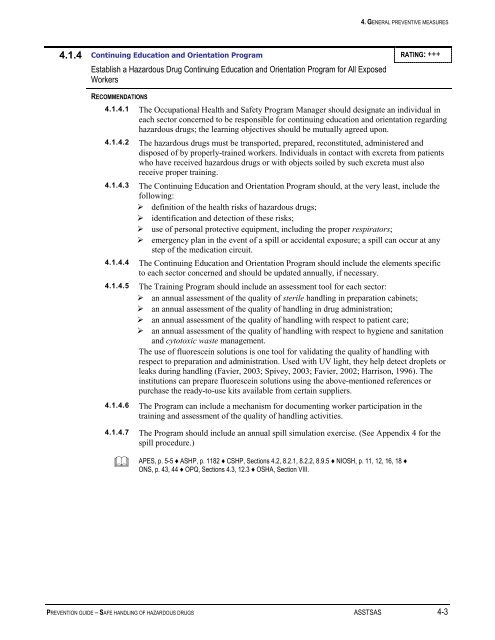Prevention Guide - Safe Handling of Hazardous Drugs - Irsst
Prevention Guide - Safe Handling of Hazardous Drugs - Irsst
Prevention Guide - Safe Handling of Hazardous Drugs - Irsst
You also want an ePaper? Increase the reach of your titles
YUMPU automatically turns print PDFs into web optimized ePapers that Google loves.
4. GENERAL PREVENTIVE MEASURES<br />
4.1.4 Continuing Education and Orientation Program RATING: +++<br />
Establish a <strong>Hazardous</strong> Drug Continuing Education and Orientation Program for All Exposed<br />
Workers<br />
RECOMMENDATIONS<br />
4.1.4.1 The Occupational Health and <strong>Safe</strong>ty Program Manager should designate an individual in<br />
each sector concerned to be responsible for continuing education and orientation regarding<br />
hazardous drugs; the learning objectives should be mutually agreed upon.<br />
4.1.4.2 The hazardous drugs must be transported, prepared, reconstituted, administered and<br />
disposed <strong>of</strong> by properly-trained workers. Individuals in contact with excreta from patients<br />
who have received hazardous drugs or with objects soiled by such excreta must also<br />
receive proper training.<br />
4.1.4.3 The Continuing Education and Orientation Program should, at the very least, include the<br />
following:<br />
‣ definition <strong>of</strong> the health risks <strong>of</strong> hazardous drugs;<br />
‣ identification and detection <strong>of</strong> these risks;<br />
‣ use <strong>of</strong> personal protective equipment, including the proper respirators;<br />
‣ emergency plan in the event <strong>of</strong> a spill or accidental exposure; a spill can occur at any<br />
step <strong>of</strong> the medication circuit.<br />
4.1.4.4 The Continuing Education and Orientation Program should include the elements specific<br />
to each sector concerned and should be updated annually, if necessary.<br />
4.1.4.5 The Training Program should include an assessment tool for each sector:<br />
‣ an annual assessment <strong>of</strong> the quality <strong>of</strong> sterile handling in preparation cabinets;<br />
‣ an annual assessment <strong>of</strong> the quality <strong>of</strong> handling in drug administration;<br />
‣ an annual assessment <strong>of</strong> the quality <strong>of</strong> handling with respect to patient care;<br />
‣ an annual assessment <strong>of</strong> the quality <strong>of</strong> handling with respect to hygiene and sanitation<br />
and cytotoxic waste management.<br />
The use <strong>of</strong> fluorescein solutions is one tool for validating the quality <strong>of</strong> handling with<br />
respect to preparation and administration. Used with UV light, they help detect droplets or<br />
leaks during handling (Favier, 2003; Spivey, 2003; Favier, 2002; Harrison, 1996). The<br />
institutions can prepare fluorescein solutions using the above-mentioned references or<br />
purchase the ready-to-use kits available from certain suppliers.<br />
4.1.4.6 The Program can include a mechanism for documenting worker participation in the<br />
training and assessment <strong>of</strong> the quality <strong>of</strong> handling activities.<br />
4.1.4.7 The Program should include an annual spill simulation exercise. (See Appendix 4 for the<br />
spill procedure.)<br />
<br />
APES, p. 5-5 ♦ ASHP, p. 1182 ♦ CSHP, Sections 4.2, 8.2.1, 8.2.2, 8.9.5 ♦ NIOSH, p. 11, 12, 16, 18 ♦<br />
ONS, p. 43, 44 ♦ OPQ, Sections 4.3, 12.3 ♦ OSHA, Section VIII.<br />
PREVENTION GUIDE – SAFE HANDLING OF HAZARDOUS DRUGS ASSTSAS 4-3

















